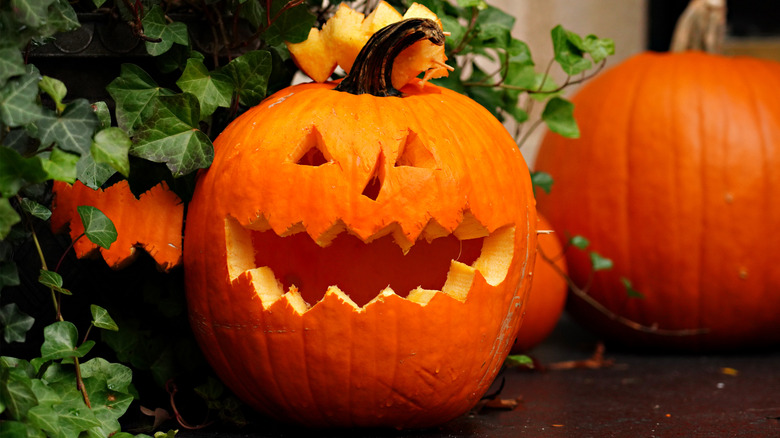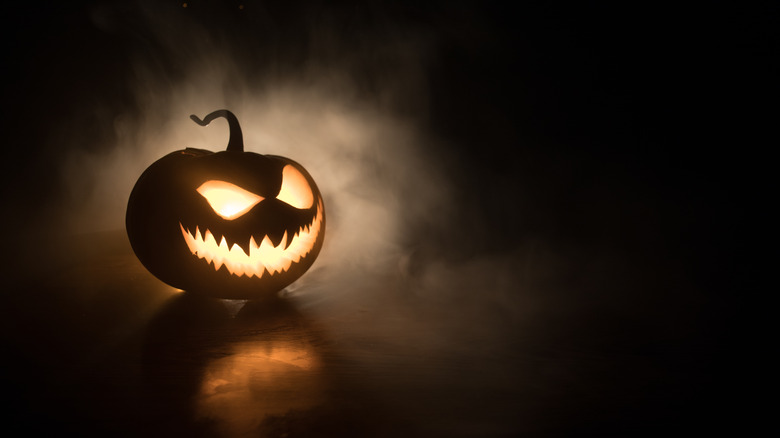The Surprisingly Spooky History Behind Jack-O'-Lanterns
It's the most wonderful time of the year again! The weather is crisp, the leaves are crunchy, and the air just smells vaguely of pumpkin spice at any given time. That's right, it's fall.
The season of gorgeous colors, delicious foods, and cozy fashion is actually steeped in quite a bit of tradition, specifically when it comes to the season's hallmark holiday. Halloween, which falls on October 31, has become inundated with iconography surrounding all the spooky things in life that we can't help but to love. But did you know that Halloween actually originated from the ancient Celtic festival of Samhain? This Pagan religious tradition actually looks quite similar to how we celebrate Halloween to this day, as the festival involved lighting bonfires, wearing costumes to ward off ghosts, and making way for "the dark half of the year" (via History). However, there's one big thing the Celts didn't seem to include in their festivals: Jack-o'-lanterns. As it turns out, these carved pumpkins have a pretty spooky origin story of their own.
The Irish used to carve horrifying faces into turnips
Jack-o'-lanterns are by no means a modern addition to Halloween. In fact, they've been a hallmark of the holiday for centuries, with reports throughout history spotting them in countless cultural iterations of the spooky celebration. Ireland was observed as the first country to decorate jack-o'-lanterns. Instead of pumpkins, though, they opted for turnips and potatoes, which were indigenous to Ireland per Irish Central.
Don't think that just because faces were carved into root vegetables that traditional Irish jack-o'-lanterns looked anything like ours do today. On the contrary, they looked nearly unrecognizable and were used to ward off unwanted visitors, not decorate a front step to mimic a Pinterest-inspired aesthetic (via Twitter). Furthermore, these early 1900s Halloween gourds weren't even called jack-o'-lanterns, and were instead deemed "ghost turnips," per National Geographic. Influxes of Irish immigrants making their way into America eventually discovered that carving into pumpkins was far more effective.
Stingy Jack was the character in this Irish folktale
So, where did the name "jack-o'-lantern" even come from?
According to historians, the idea was born from an Irish folktale about a man named Stingy Jack. The legend says that Stingy Jack was a miserable drunkard who was always playing tricks on people. One day, Jack invited the Devil for a drink, but Jack didn't want to pay — thus his nickname. Jack managed to convince the Devil to turn himself into a coin so that Jack could pay for drinks for the two of them, but once the Devil did so, Jack changed his mind and kept the money. He then put the coin into his pocket which sat next to a silver cross, subsequently making it impossible for the Devil to change back into his original form (via History).
Jack eventually decided to free the Devil, but only after he promised not to bother Jack for a year. He also made him promise that he wouldn't claim Jack's soul upon his death, in the hopes that he'd go to heaven and not hell. The Devil obliged.
His ghost was referred to as "Jack of the Lantern"
The next year — yet again — Jack tricked the Devil by convincing him to climb up a tree to retrieve a piece of fruit. Once the Devil climbed the tree, Jack carved a cross into the trunk so the Devil couldn't come down and made him swear he wouldn't bother Jack for another ten years.
Eventually, when Jack died, the legend says that God didn't allow him into heaven and the Devil couldn't allow him into hell. Instead, Jack was sent into a sort of limbo, eternal night, and was said to use a burning coal inside a carved-out turnip to light his way through the darkness, forever roaming the earth alone. The Irish referred to the ghost as "Jack of the Lantern," which eventually turned into "Jack O'Lantern" (via Irish Central).
So next time you're carving figures and faces into a pumpkin to celebrate Halloween, make sure you keep Stingy Jack in mind — as legend has it that he still roams the earth to this day.



